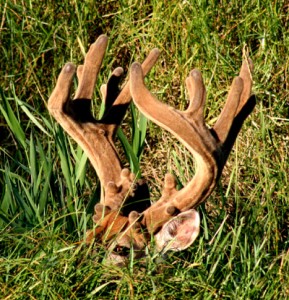Skip to content
5 Interesting Things About Velvet Deer Antlers
- 1.
 In July, velvet antlers grow via a complex system of blood vessels, which causes them to be hot to the touch. Top whitetail scientist Dr. Grant Woods notes, “There is so much blood carrying protein and minerals to a buck’s antlers this time of year that even small antlers are easily detected by thermal imaging devices. Antler tines show up like neon signs when flying over with thermal cameras in summer.”
In July, velvet antlers grow via a complex system of blood vessels, which causes them to be hot to the touch. Top whitetail scientist Dr. Grant Woods notes, “There is so much blood carrying protein and minerals to a buck’s antlers this time of year that even small antlers are easily detected by thermal imaging devices. Antler tines show up like neon signs when flying over with thermal cameras in summer.”
- Tiny hairs on the velvet stick out and make velvet antlers look bigger than they are. The hairs act as a radar system so the buck won’t bump into trees, fence posts, etc. and damage his soft antlers.
- Sebum, a semi-liquid secretion, on the hairs of the velvet give it a shiny look. Scientists say sebum acts as an insect repellent to keep biting flies off a buck’s rack and face.
- In early August velvet antlers begin to change from soft and pliable to hardened bone. “A buck’s antlers will change from looking swollen or bulbous at the tips of the tines to a more normal diameter,” notes Dr. Woods. “Once this change in appearance occurs the buck won’t add much beam or tine growth.”
- By mid-August most of the antler growth for the year is done.
Page load link
 In July, velvet antlers grow via a complex system of blood vessels, which causes them to be hot to the touch. Top whitetail scientist Dr. Grant Woods notes, “There is so much blood carrying protein and minerals to a buck’s antlers this time of year that even small antlers are easily detected by thermal imaging devices. Antler tines show up like neon signs when flying over with thermal cameras in summer.”
In July, velvet antlers grow via a complex system of blood vessels, which causes them to be hot to the touch. Top whitetail scientist Dr. Grant Woods notes, “There is so much blood carrying protein and minerals to a buck’s antlers this time of year that even small antlers are easily detected by thermal imaging devices. Antler tines show up like neon signs when flying over with thermal cameras in summer.”




